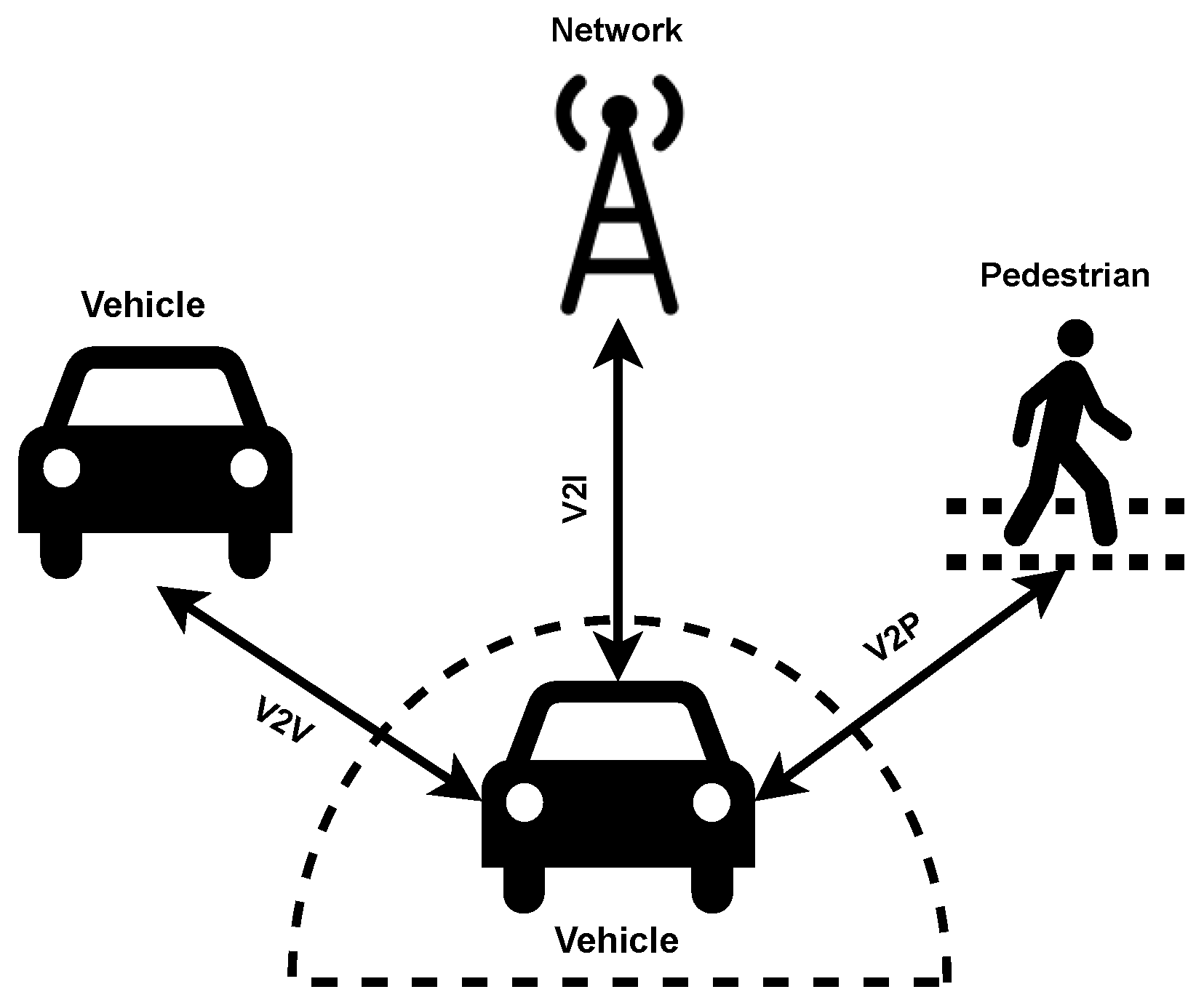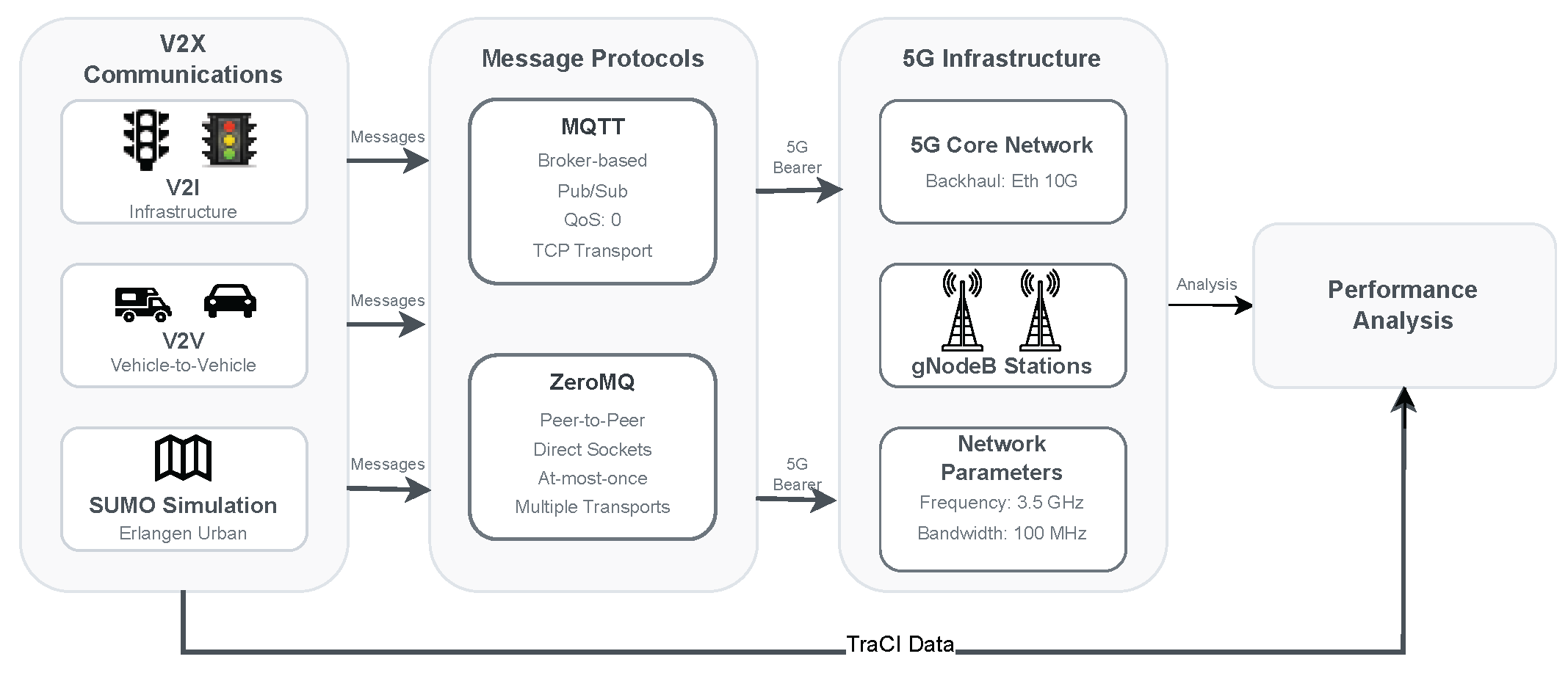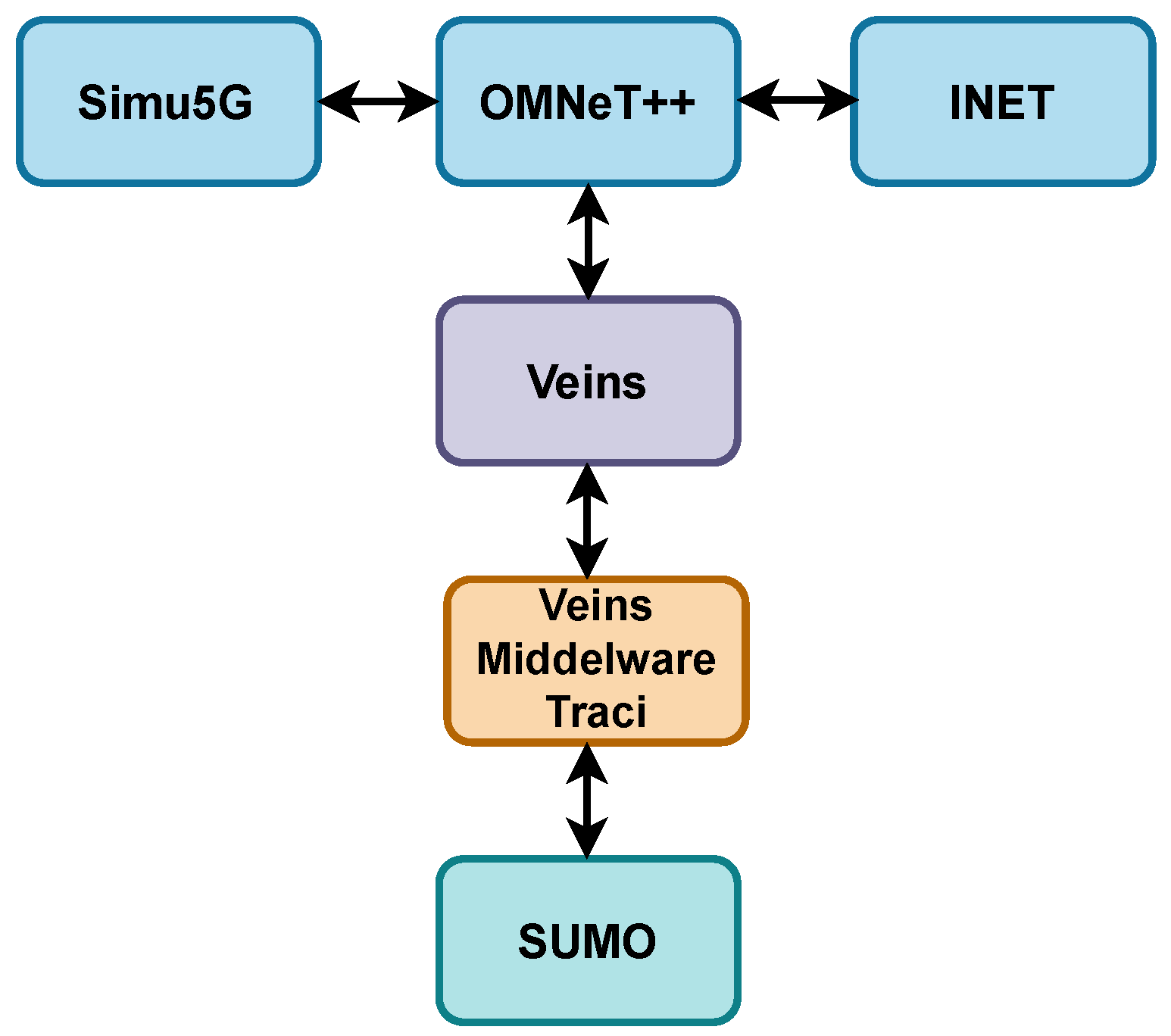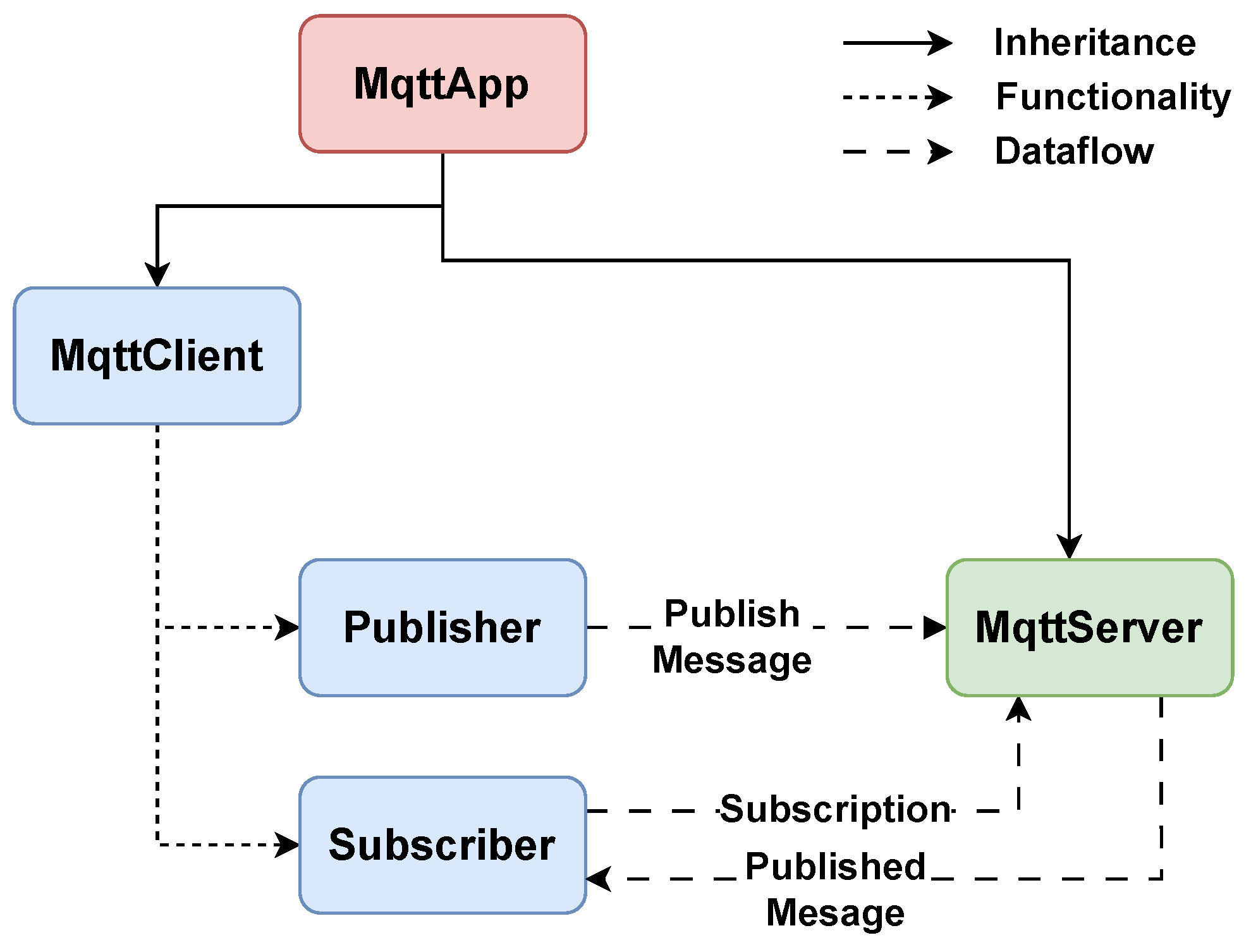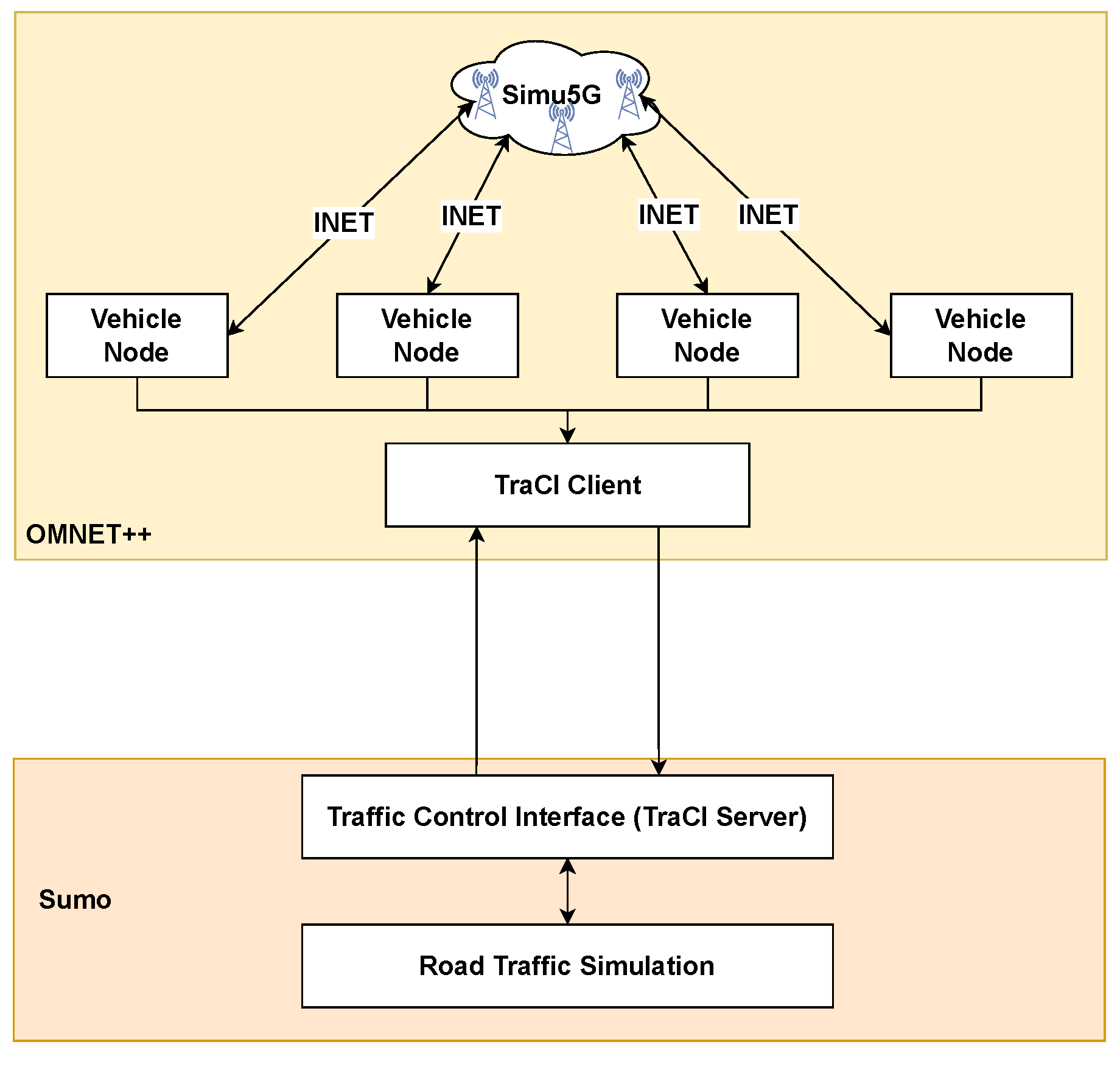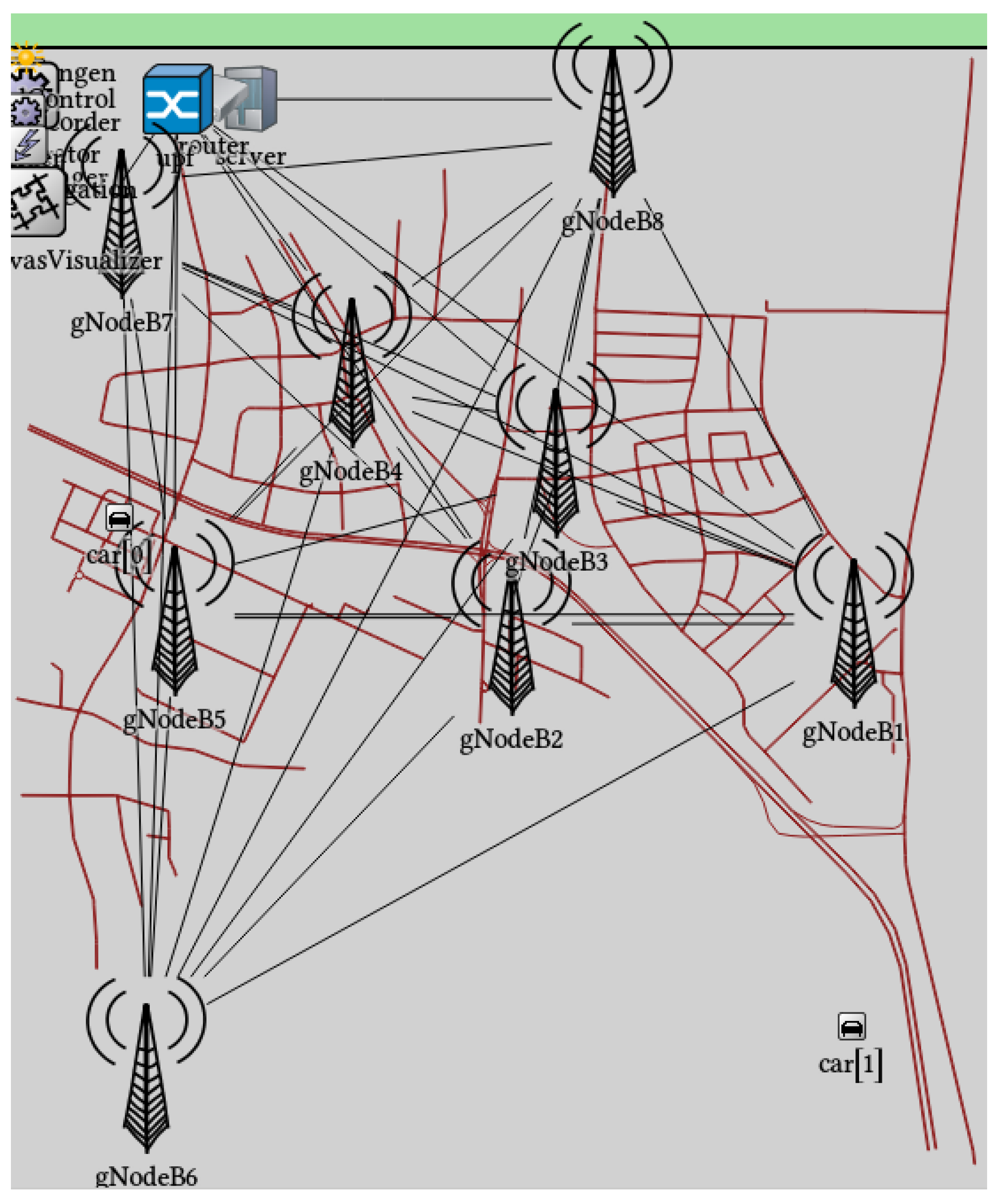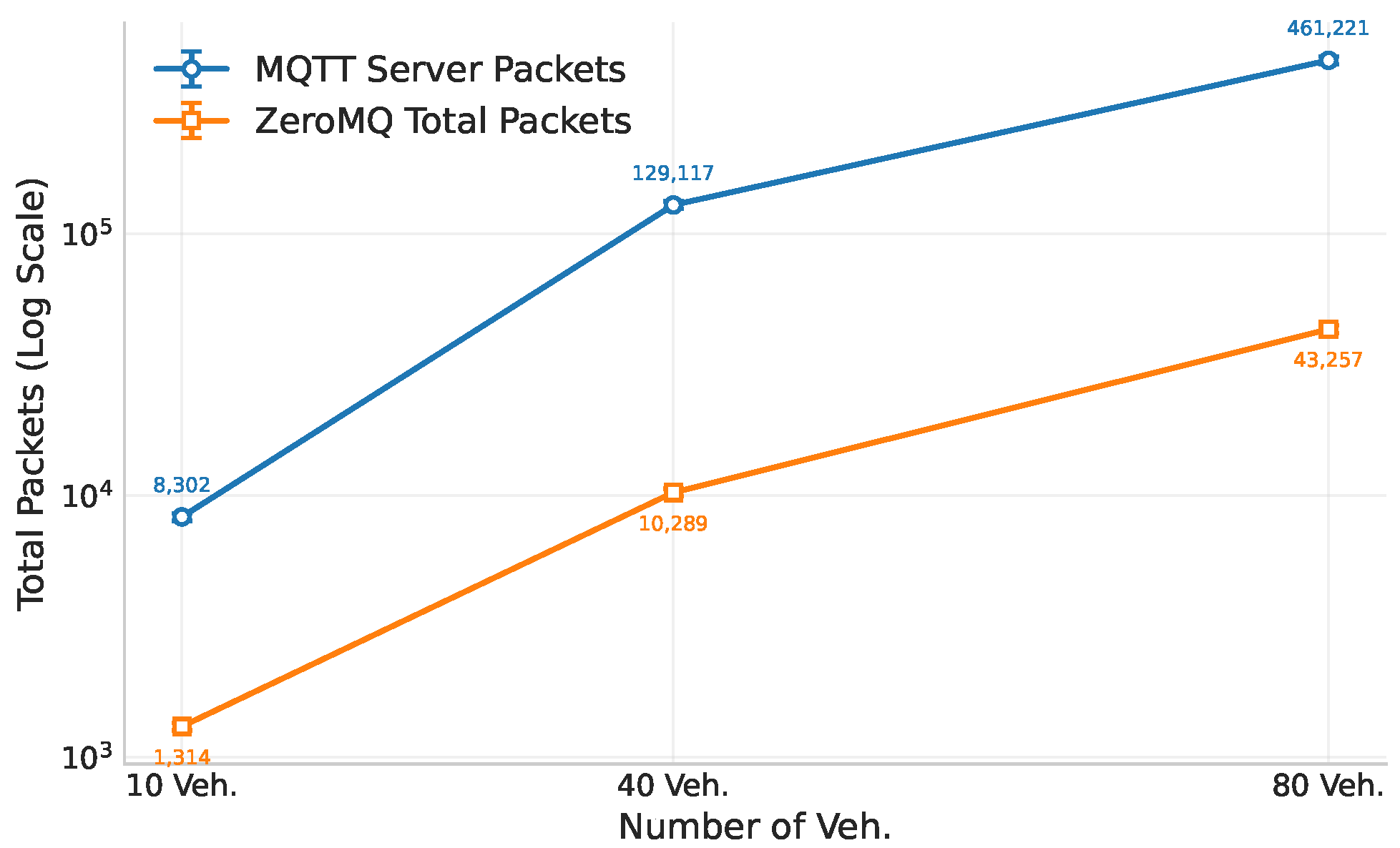2.1. Related Work
The evolution of 5G networks has introduced several key enhancements, including improved support for massive multiple input multiple output (MIMO) systems, ultra-low latency through edge computing, and dynamic resource allocation through network slicing [
6]. These technological advancements have been pivotal in the increasing adoption of C-V2X, as they address some of the limitations associated with Dedicated Short Range Communication (DSRC), such as limited range and scalability. C-V2X operates using two main communication interfaces: the Uu interface, which utilizes existing cellular infrastructure for wide-area coverage, and the PC5 interface, which enables direct peer-to-peer communication between vehicles and other intelligent transport systems [
7,
8].
Authors in [
9] conducted a comprehensive trial of C-V2X communication in LTE networks, utilizing both the 3GPP PC5 (sidelink) and Uu (cellular) interfaces to evaluate performance under real-world conditions. The study demonstrated the feasibility of C-V2X communication in high-speed vehicular scenarios, confirming successful data exchange even at relative speeds of up to 220 km/h. For direct V2V communication over the PC5 interface, the trial observed a packet error rate (PER) of less than 10% for distances up to 1200 m. Furthermore, the median end-to-end latency between two test vehicles was measured to be under 20 ms, indicating reliable low-latency performance critical for safety applications.
In addition to sidelink communication, the trial assessed the Uu interface, which enables V2N communication through cellular infrastructure. Testing conducted over the NTT DOCOMO commercial LTE network during the connected state revealed a median end-to-end latency of approximately 50 ms. Even at the 95th percentile, the end-to-end latency remained below 60 ms, demonstrating the potential for C-V2X to support a wide range of vehicular applications, including cooperative driving and traffic management.
Several studies [
8,
10,
11] have explored the integration of 5G cellular infrastructure into V2X communication, analyzing both the potential benefits and challenges associated with its deployment. The 5GAA has been instrumental in promoting the use of 5G for V2X applications, providing standardization documents and insights into stakeholder support. Notably, the 5GAA C-V2X use case document [
12] outlines various mobility scenarios where the low-latency capabilities of 5G networks play a crucial role in enabling reliable and efficient V2X communication. Vieira et al. [
13] proposed a hybrid roadside and cloud-based vehicular communication framework that integrates MQTT brokers for cooperative intelligent transport services (C-ITS). Their architecture highlights the balance between edge and cloud layers in achieving scalable, low-latency vehicular data exchange within 5G-based C-V2X systems. Similarly, Coll-Perales et al. [
14] investigated 5G enabled V2N2V architectures that support cross-stakeholder information sharing for cooperative driving, highlighting the role of network slicing and multi-operator coordination in future V2X ecosystems.
A critical consideration in deploying V2X communication over cellular networks is the selection of an appropriate application layer protocol capable of scaling with increasing vehicular data demands. MQTT, a lightweight publish–subscribe messaging protocol originally designed for IoT applications, has emerged as a promising candidate for V2X communication [
15]. Extensive research has been conducted to evaluate MQTT’s suitability for vehicular applications, particularly in handling telemetry data transmission. Studies such as [
15,
16,
17] analyze MQTT-based publish–subscribe architectures for transmitting vehicle telemetry data, often formatted in standardized message formats such as Cooperative Awareness Messages (CAM). Additionally, security considerations are a significant aspect of V2X communication, and research efforts like [
18,
19] explore methods to enhance MQTT security, ensuring safe and reliable transmission of critical vehicular data over open 5G networks.
While MQTT has been widely adopted for its lightweight publish/subscribe model, security remains a critical consideration, especially in vehicular networks where message integrity and confidentiality are paramount. To address these challenges, the incorporation of Transport Layer Security (TLS) has been investigated to enhance MQTT-based communication reliability and privacy. Gavriilidis et al. [
20] conducted an empirical evaluation of TLS-enhanced MQTT implementations on IoT devices for V2X scenarios, demonstrating improved data protection with moderate computational overhead. Furthermore, Hmissi and Ouni [
21] proposed TD-MQTT, a distributed multi-broker MQTT framework designed to improve scalability and fault tolerance—features that could be beneficial for large-scale vehicular communication systems with high data volume.
The integration of edge computing with 5G-based V2X is another area of active research, as edge-assisted solutions have been shown to significantly improve the performance of vehicular networks. Studies such as [
22,
23] investigate techniques that leverage Multi-Access Edge Computing (MEC) to facilitate low-latency data transmission in critical vehicular scenarios. Notably, [
22] reported an 80% improvement in end-to-end latency when utilizing MEC hosts compared to conventional network architectures. These findings highlight the potential of edge computing in mitigating network congestion and ensuring faster response times for time-sensitive V2X applications.
Nguyen et al. [
23] conducted an evaluation of the MQTT protocol in a simulated LTE network environment, focusing on its performance in vehicle-to-cloud communication. Their study involved testing a real cloud platform while handling highly scaled vehicle data generated from simulations. To assess system resilience and efficiency, they subjected the platform to extreme load conditions, simulating large-scale vehicular deployments with high message throughput. The evaluation aimed to measure key performance indicators such as message latency, packet loss, and scalability under heavy network and computational loads. Their findings provide insights into the feasibility of using MQTT for large-scale vehicular applications, particularly in scenarios requiring real-time data exchange between connected vehicles and cloud-based services.
ZeroMQ is widely adopted in industry due to its high performance and flexible messaging patterns. However, ZeroMQ has not received much attention in research works related to IoT and V2X communication. Most existing research focuses on well-established protocols like MQTT, CoAP, or REST-based architectures. While some works have explored ZeroMQ’s potential in simulation frameworks, industrial automation, and general-purpose asynchronous messaging [
24,
25], its performance, reliability, and resource efficiency in vehicular environments remain underexplored. Pilz [
26] introduced the vehicleCAPTAIN middleware, which employs ZeroMQ as its core communication layer, demonstrating the viability of brokerless architectures for multi-interface vehicular communication and simulation frameworks.
2.2. Theoretical Background
While various research efforts have evaluated C-V2X performance at the physical (PHY) and sub-MAC layers [
27,
28], there remains a notable gap in studies focusing on the performance of application layer protocols like MQTT and ZeroMQ. MQTT has been widely used in IoT applications, whereas ZeroMQ has been extensively used in distributed computing systems. However, these protocols have not been sufficiently explored in V2X environments, particularly in terms of performance, scalability, and efficiency over 5G networks.
Figure 1 presents the integration of V2X communication with MQTT and ZeroMQ over 5G network infrastructure.
2.2.1. 5G-Enabled Vehicle-to-Everything (V2X) Communication
5G, the latest leap in cellular technology, offers faster, more reliable, and low-latency connections than 4G/LTE, making it ideal for high-speed mobility scenarios. Although 6G research has begun, 5G deployment is still expanding worldwide. Its capabilities are crucial for Connected and Autonomous Vehicles (CAVs), allowing onboard units to maintain stable, high-speed connections and share vital traffic data in real time [
29].
While LTE-V2X, introduced in 3GPP Release 14 and 15, marked a significant step in enabling direct and network-based vehicular communications, it offers some limitations in terms of latency, scalability, and QoS support [
30]. In contrast, 5G-NR-V2X, introduced in 3GPP Release 16, offers enhanced capabilities such as QoS-aware resource allocation and advanced sidelink communication modes, providing up to 20% improvement in communication reliability and reducing power consumption by up to 95% compared to full-sensing approaches [
31]. These improvements are crucial in ensuring safe and low-latency communication for connected and automated vehicles.
Table 1 lists the basic 5G parameters that aid V2X communication (
Figure 2). Key 5G features enabling C-V2X include:
Low Latency: essential for real-time communication.
Massive MIMO: allows multiple vehicles to communicate simultaneously.
Multi-access Edge Computing (MEC): improves response times by processing data near the edge.
URLLC: ensures reliable and near-instantaneous communication.
Network Slicing: creates dedicated virtual networks for V2X applications.
Enhanced Security Mechanisms: encryption, authentication, and intrusion detection.
AI/ML Integration: for predictive traffic management and anomaly detection.
Seamless 6G Evolution: future integration with THz communication, AI-powered analytics, and quantum-secured networks [
32].
Figure 2.
V2X communication.
Figure 2.
V2X communication.
With these 5G capabilities, modern vehicles equipped with radar, LiDAR, ultrasonic sensors, and cameras can exchange real-time data for safe and efficient operation.
Among the key technologies enabling V2X are DSRC (IEEE 802.11p) [
33] and C-V2X). DSRC provides short-range low-latency communication, whereas C-V2X leverages cellular infrastructure for ultra-low latency, larger coverage, and high-speed mobility support [
34,
35]. Direct C-V2X includes V2V and V2I communication, while C-V2X also supports V2N communications over licensed spectrum [
36,
37].
Table 1.
Key 5G parameters [
38].
Table 1.
Key 5G parameters [
38].
| Parameters | Threshold Value |
|---|
| Latency in the air link | <1 ms |
| Latency in end-to-end (device to core) | <10 ms |
| Connection density | vs. 4G LTE |
| Area capacity density | 1 (Tbits/s)/km2 |
| System spectral efficiency | 10 (bit/s)/Hz/cell |
| Peak throughput | 10 Gbit/s |
| Energy efficiency | >90% improvement over LTE |
2.2.2. MQTT Overview
To efficiently transmit the massive data generated by connected vehicles, lightweight messaging protocols such as MQTT are employed. MQTT is particularly well-suited for IoT and V2X environments, where bandwidth may be limited and network reliability can fluctuate [
39]. It uses a broker-based architecture with a publish/subscribe model, enabling multiple subscribers to receive messages from publishing clients simultaneously.
Figure 3 shows MQTT communication for V2X where each vehicle represents the MQTT client. These clients publish messages to the broker, and also subscribe to particular topics to receive messages.
MQTT uses Transmission Control Protocol (TCP), Quick UDP Internet Connections (QUIC), or WebSockets for reliable, secure communication. Clients publish to brokers under specific topics, and subscribers receive messages accordingly. To support real-time, low-latency updates, brokers avoid message storage. MQTT’s persistent sessions, QoS levels, and publish/subscribe model make it ideal for V2X applications, allowing infrastructure nodes to broadcast messages to multiple vehicles efficiently while ensuring reliable delivery [
40].
2.2.3. ZeroMQ (MQ)
ZeroMQ is a high-performance asynchronous messaging library designed for building distributed or concurrent applications. It abstracts away low-level networking complexities, enabling developers to focus on application logic without worrying about socket management or network transport details.
Figure 4 presents the work-flow of ZeroMQ. ZeroMQ is lightweight, highly efficient, and supports various messaging patterns, including Request-Reply, Publish-Subscribe, Push-Pull, Exclusive Pair, Pipeline, and Survey-Response. These patterns facilitate different communication scenarios, such as synchronous request-reply interactions, asynchronous message broadcasting, load balancing, direct point-to-point communication, processing pipelines, and gathering feedback from multiple participants [
41].
ZeroMQ supports multiple transport protocols, including TCP, Inter-Process Communication (IPC), Pragmatic General multi-cast (PGM), and inter-thread communication, providing flexibility for different system architectures. Additionally, ZeroMQ offers built-in message queuing, automatic reconnection, and fault tolerance, ensuring robust communication even in unreliable network conditions. Its efficient design minimizes latency, making it well-suited for real-time applications such as financial trading, distributed logging, sensor networks, and parallel processing.
While messaging protocols like ZeroMQ provide efficient application-layer communication, the success of vehicular applications also depends on the underlying wireless communication standards. V2X communication has evolved significantly with the development of cellular technologies. Early vehicular communication research focused on DSRC, based on the IEEE 802.11p standard [
33]. This stack, including IEEE 1609.x and SAE J2735 [
43] was designed to support safety-critical V2V/V2I applications with low latency [
34].
2.3. Comparative Studies on MQTT and ZeroMQ
Several studies have examined the performance of lightweight messaging protocols in IoT and vehicular communication environments, but direct comparisons between MQTT and ZeroMQ remain limited. A notable distinction is that, unlike MQTT, ZeroMQ does not require the presence of a broker, as it follows a decentralized approach. Gokhale et al. [
44] evaluated Data Distribution Service (DDS), MQTT, and ZeroMQ under diverse IoT traffic conditions and found that while ZeroMQ achieved significantly lower latency and higher throughput, MQTT offered better reliability due to its broker-managed architecture. Similarly, Cleland et al. [
45] analyzed multiple communication protocols, including MQTT, Advanced Message Queuing Protocol (AMQP) and ZMTP (the ZeroMQ transport layer) in edge-based federated learning settings and highlighted the trade-off between ZeroMQ’s low latency design and MQTT’s built-in delivery guarantees. Khalil et al. [
46] provided a broader comparison of messaging protocols for IoT systems, concluding that ZeroMQ’s brokerless flexibility improves scalability in well-connected environments, while MQTT remains advantageous where ordered, reliable delivery is critical. However, despite these valuable insights, few works have explored MQTT and ZeroMQ within a unified 5G-enabled V2X simulation framework.
